 Leading Blog | Posts by Category |
 Leading Blog | Posts by Category |
09.13.24

Dynamic Drive: The 7 Keys to Sustainable Success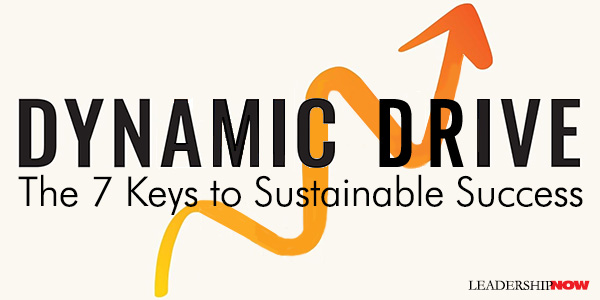
THERE is drive, and then there is Dynamic Drive. Dynamic Drive is about aligning what you do with who you are. Author Molly Fletcher says, “It’s about figuring out whether there are parts of your life where you are playing small or safe or are dissatisfied.” It’s about fulfillment. Dynamic Drive is about the journey. It’s about becoming. “Dynamic Drive is the process by which we implement and sustain intentional change. It’s a belief system that the ‘yeses’ will come if we stay the course, and the ‘nos’ along the way are just feedback.” To begin, you need a sense of who you want to become. It is your purpose. It’s what keeps you going when motivation fails you. Complacency is the enemy of drive. “Complacency is a feeling of self-satisfaction that keeps you from reaching your potential.” Success can lead to complacency, but you can’t remain in that state if you are to reach your potential. “Complacency happens when you don’t recognize that you’re stuck or you aren’t willing to do anything about it.” In a state of complacency, you miss the gaps between where you are and where you want to be. You’re compromised and on autopilot. You have to make a move. “Change is hard; it’s uncomfortable, particularly when you have been in a current state for a long time.” Dynamic Drive is the process Fletcher created by which we implement and sustain intentional change. It’s not about achievement. It’s about what you become in the process. “If the sole focus is achievement, what comes next are dark, empty, lonely moments.” There are seven keys to using the power of Dynamic Drive for sustainable success. First Key: Mindset The mindset she describes is a possibility mindset. A mindset that serves your purpose. “You are the narrator of your life story. The old story is usually tied to something that’s holding you back. The way you’re talking to yourself isn’t serving you. What you tell yourself matters, and it’s time to take control of that messaging.” Second Key: Energy Be intentional about how you spend your time. “You must have the guts to ditch the things that don’t bring meaning to our priorities in life. Invest more time in the things that sustain and replenish your energy and eliminate or better manage those things that drain your energy.” Third Key: Discipline Discipline is the bridge that takes you to your goals. “The bridge is the daily grind, the behaviors and habits that get you to your goals.” Take the long view and be intentional about every action you take. Fourth Key: Curiosity Curiosity leads to learning, and learning leads to growth. Curiosity that leads to action is the edge you need for sustainability. Curiosity “unlocks new opportunities and strengthens connections. A mixture of confidence and vulnerability is necessary to be curious. It takes both to acknowledge that you don’t have all of the answers.” Fifth Key: Resilience “Resilience is the ‘capacity of a system, enterprise or person to maintain its core purpose and integrity in the face of dramatically changed circumstances.’ Resilience is built through action. You can’t think your way into it; you have to do it.” It is important to understand, too, that “it’s inevitable that your Dynamic Drive will be interrupted—that’s what makes it dynamic. Resilience is the key to embracing the unexpected hiccup as just that, and not the decline of your Dynamic Drive.” Sixth Key: Connection Connections are built through conversations and time spent with others. Building a culture of support will help you to sustain success and maximize your impact through the success of others. Build relationships that amplify your Dynamic Drive. “Positive and ambitious friends and colleagues can inspire us to grow, learn, and push ourselves outside of our comfort zones. They introduce us to new opportunities or experiences we might not have considered on our own. Close friends often provide emotional support and encouragement.” Seventh Key: Confidence Confidence is the belief in your abilities. Confidence wanes at times. If it doesn’t, you probably aren’t pushing yourself as you need to. It doesn’t come from your comfort zone. Confidence comes through actions that push you. “Confidence helps you take action, and the more action you take, the more confident you become.” Discovering your purpose takes time and can change through the seasons of your life. “Purpose is something that you can uncover through doing, through action, and through showing up. Get clear on direction, do the work of reflection, and then take it out to the streets. You’ll continue to refine it. You’re molding it constantly. Putting yourself out there, even in less-than-ideal circumstances, allows you to learn about your purpose and to dig deeper into how it feels as you’re engaging it. You’ll see the gifts and benefits of a clear purpose when you start to live into it. 
Posted by Michael McKinney at 03:57 PM
02.24.23

Intrinsic Motivation: How to Be Motivated by Doing What You Do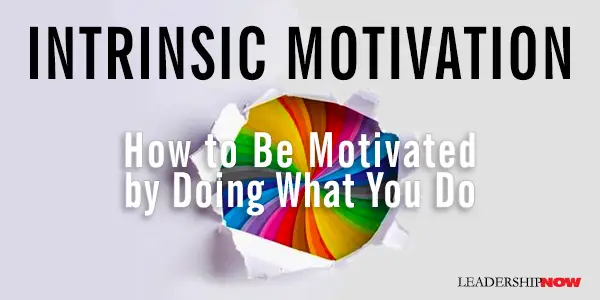
NO MATTER WHAT you are doing, you can be motivated by the work you do. Even if you hate your job, you can learn to love any activity. The key is to create excitement around the experience of doing what you do – intrinsically. It is an inside job. Performance coach Stefan Falk has written Intrinsic Motivation: Learn to Love Your Work and Succeed as Never Before to help you do just that. We can learn to love any activity by rewiring our brains to Focus on Exciting Outcomes or FEOs. The foundation for doing that is found in five success principles that have worked for Falk and others he has shared them with:
The end goal of all of these principles is to cultivate excitement which enables you to love what you do. We sabotage ourselves when we make excuses for not loving our work. The most common excuses are too much to do, too stressed, poor relationships, and unfair performance assessments. There are toxic work environments that reflect on where you work and not why you hate your work. Falk says, “unless you are in an exceptionally bad working environment, in which case you should leave, your excuses are obstacles of your own creation.” So, what’s the answer to this conundrum? The answer is in learning to master your mind. Falk offers “proven step-by-step tools and approaches that will make it easier and less energy-consuming for you to master your mind and to think and act deliberately in your professional life.” To get your head around how to make Exciting Outcome-Focused Behavior or FEOs part of your normal way of operating at work, you need to understand that your work tasks have nothing to do with whether you love them. What makes a work task or activity lovable is how you think about the result you want to achieve. The more exciting that result is to you, the more time you’ll spend thinking about how to best perform that activity. What makes this so difficult to do is that we too often think of work as work and not something we are to enjoy. And we (and our organizations) are activity focused. Organizations thrive on activity-based goals such as “Develop the process for customer complaints,” “Move our data to the cloud,” or “Execute our digital transformation.” The common denominator among almost all company goals is their lack of clear and exciting outcomes. Most professionals are evaluated and rewarded based on whether they have executed an activity and not on what they achieved by doing so. We have the power to think about our work in ways that make it lovable. Every task can be made interesting because every task has endless complexity and can be performed with endless variations. That, of course, requires that we overcome our reluctance to expend energy on deliberate thinking. For example, Falk considers the simple task of asking a colleague for information. We might ask ourselves: • What exactly do I need to know, and how do I express it?
That is certainly intentional thinking. Falk then offers chapters discussing approaches to our work arranged from easy, moderate, and demanding to implement. These include: • Set expectations every day and bring home something exciting and interesting to tell your kids
And many more. Intrinsic motivation happens when you feel challenged. You will need to constantly increase the complexity and challenge of your work. The way you perform your tasks can always be improved, even if you perform them well. To be an intrinsically motivated person, you will need to look for moments when you should be challenging yourself rather than performing on autopilot. No workplace, good or bad, will matter if you haven’t mastered your mind. That said, a good workplace will make it easier to engross yourself in your work. More importantly, you should look for an organization that is “designed to enable its people to experience a sense of autonomy.” 
Posted by Michael McKinney at 07:11 AM
12.23.22

Motivation: To Do or Not to Do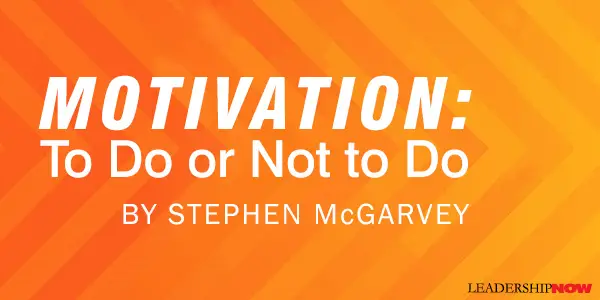
DIFFERENT things motivate different people in different ways. The more we understand the nature of how someone is motivated, the easier it is for us to adjust our communication to match up with their natural motivational tendencies. The key is to pay attention to their language because it contains elusive clues to their underlying motivational traits. What are motivational traits? Everyone has a number of underlying factors that motivate them. Once you understand this key distinction, you can then adjust your communication approach to align with these traits, empowering you to be more persuasive with a variety of people. For example, knowing that your staff members, Michael and Afua, are motivated by high financial compensation is important. Moreover, the details of their motivational traits can help you make the most of this knowledge. Understanding Away from and Toward Motivation One motivational trait you can quickly understand and adjust to is the direction of motivation. Some people are motivated by “away from,” that is, what they can avoid, prevent, or eliminate. In other words, they are motivated to move away from what they don’t want to have happen in their lives. In comparison, other people are motivated by moving “toward” things that they want to achieve, accomplish, or attain. For example, Michael and Afua both value money, and they both negotiate strongly for more compensation in performance reviews. But why? Are they moving away from or toward something money offers them? You can find out by asking them questions and listening to their language. When you talk to Michael and ask him what is important about money, he reveals that he is stressed about how he will fare financially after retirement. He tells you that he doesn’t want to struggle in retirement like his parents. Michael is moving away from a retirement reality he fears. When you talk to Afua, she reveals that she wants a higher salary so that she can more easily afford the vacation rental she has always wanted. Afua is moving toward her ideal vacation. Both Michael and Afua can be motivated with financial incentives, and they can also be motivated by framing a discussion about that incentive in the context of what they are moving away from or toward. Money is just a means that gets people closer to achieving what they value, after all. Say you want to motivate both Michael and Afua to agree to put in additional discretionary work time over the weekend to meet a fast-approaching deadline on a major project. For Michael, you might suggest that the bonus he would receive from doing this extra work could be invested in a fund to build up his retirement nest egg so that he can avoid worrying about financial struggles when he retires. With this knowledge about Afua, you may realize that she is motivated by money as it relates to the prospect of taking more luxurious vacations. For her, you could suggest that the bonus she makes could be put toward spoiling herself and booking her dream vacation rental. There are many other ways to leverage your understanding of the direction of motivation, and as you begin to recognize people’s motivation, you will think of interesting ways to appeal to their specific orientation. Understanding Options and Procedures Motivation Another key motivational trait is whether someone is oriented to options or procedures. Someone who is options-oriented is motivated by possibilities, choice, and change. Someone who is procedures-oriented is motivated by pattern, process, and the “right” way to do something. You have likely found that it has been easier to motivate people who share your preference for options or procedures. It is necessary to have people of both orientations in your organization, and both are found in about equal numbers in the workforce. To identify people who are options-oriented, look for those who like to create, design, and develop. Those with this motivational tendency enjoy figuring things out as they go, rather than make a detailed plan. They want to break the rules and come up with something unique. However, they are also likely to suffer from a lack of follow-through and may get distracted easily. On the other hand, those who are procedures-oriented will want to find the “right” way to do something and then avoid changing the process that brought about the “right” end result. They want to plan carefully, and they have an incredible ability to follow through on a process or a whole project to completion. They care about “how” and can be so focused on process and details that they may miss the bigger picture or alternative ways of accomplishing goals. It is best to think of motivational traits as a spectrum rather than a definite label that you can apply to a person. All people fluctuate in these (and other) motivational traits depending on a number of factors. Some people, roughly 20%, will appear to be a combination of being motivated by both options and procedures. Determining which motivational styles an individual is currently demonstrating will allow you to better match them, resulting in an increased ability to motivate them. Procedures-oriented people will be more responsive to phrases such as:
Options-motivated people will be more responsive to phrases such as:
Applying Motivational Tools Options/procedures and away from/toward motivational traits are rich tools to help you identify the best language patterns to use with different people as you seek to motivate them. Note, there are even more motivational traits for you to explore, including internal/external and sameness/difference. As with all knowledge that enables you to be highly persuasive, you have a responsibility to apply this information ethically and with utmost integrity. Exploring and applying your understanding of any of these traits will equip you to be more masterful as you Ignite a Shift.  
Posted by Michael McKinney at 06:57 AM
03.07.22

Redefining Ambition and Career Development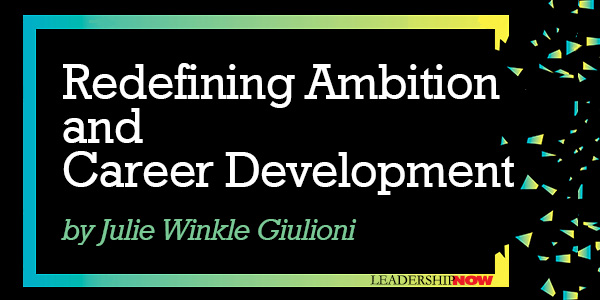
MANY definitions of “leadership” exist; but the ones that always resonate for me involve an element of bringing people along, helping them grow and progress, facilitating the development of them as people and their careers. And I have the feeling that similar definitions are deeply held by many leaders – especially given the frequency of one question I’m asked over and over: “What should I do with my ‘I’m good where I am’ employee who lacks ambition, doesn’t seem to want to grow, and is completely disinterested in moving up, over, or anywhere?” My answer to these leaders – who can’t help but feel that they’re shirking their responsibility if they aren’t motivating people to aspire to more – often is, “celebrate them… then get right to work challenging your own career development mindset.” It’s easy to impose our values, priorities, and aspirations on others. But the truth is that we each have a unique definition of what success looks like and how to achieve it. Appreciating and acting upon these differences is key to unlocking potential, motivation, and growth – even with those who appear outwardly disinterested in career development. And doing this involves going deep and wide – deep into understanding the individual and wide in terms of expanding your definition of career development. Understand the Individual Let’s face it, employees may be satisfied where they are for any number of reasons. Perhaps they’re deeply self-aware. They know what they’re good at, what they’re interested in, and what they love. Maybe they’ve found a comfortable niche within which they experience a sense of purpose and meaning. They might have figured out how to make work fit within their broader lives and other priorities. Or maybe they’ve gotten a glimpse into the headaches that you and other leaders experience on a regular basis and have consciously decided to take a pass. Disinterest in moving up doesn’t mean someone is unambitious; it simply means the leader needs to become more interested in understanding what’s important to the person and where their ambitions lie. Expand the Definition of Career Development When leaders engage with employees in candid conversations aimed at deepening their understanding of the individual, they frequently discover that the problem isn’t that these people lack ambition. Instead, it’s that we all have lacked the language – concrete ways to talk about career development – that aren’t inextricably connected with promotions, positions, and moves which don’t interest all employees. Careers and development are far bigger than the traditional trajectory up the org chart. Many employees recognize that careers operate between and beyond the artificial markers of new positions. One’s current role can become a rich sandbox for continuous growth… if we reframe the conversation and introduce seven other dimensions that are deeply meaningful to people who may not want to go anywhere but would welcome the opportunity for growth in place. Research I conducted for my new book, Promotions Are So Yesterday, suggests that there are seven other development dimensions that offer more interesting ways for employees to grow the than the classic climb up the corporate ladder. They include:
These seven dimensions offer leaders who are committed to ensuring that everyone grows the tools they need to facilitate meaningful development – even with those who have little interest in promotions. For instance, a new role is not required to introduce interesting and meaningful challenges into someone’s work life. People don’t need a different title to expand their network and learn from and through different people. A position change isn’t a pre-requisite for changing up one’s work to offer greater value or contribution. Employees don’t have to go anywhere to experience the powerful learning that comes along with making greater or more complex decisions. And the good news is that these seven dimensions – unlike promotions – are completely within your control. You and the employee can agree upon countless ways to tap their interests, motivations, and ambitions with development opportunities that are available right within their current role. So, if you’re a leader who measures your success by the growth of others, these seven dimensions will help you promote career development without promotions. Unlocking new possibilities may turn some ‘I’m good where I am’ responses into ‘I’m ready to get even better where I am!’  
Posted by Michael McKinney at 07:38 AM
07.10.19

How to Be an Engaging Leader in a World of Robotics, AI, and Digitization
MANY of today’s leaders are saying: I know leadership is about people, not tasks; effectiveness, not efficiency. However, the rapid increase of robotics, AI, and digitization are a disruption. It’s leading us to increased depersonalization and disengagement with our employees. How do I keep the digital demands of today from overwhelming my business? I want to keep my best people engaged, remain competitive, and stay on the growth path! If these are your feelings, you are not alone! Many business leaders are perplexed by the task of leading in an ever-increasing technological world. Yes, we are leaders of people, and yet it feels as if technology and other digital demands keep us from investing in our most valuable resource, our people. In the midst of managing these exponential leaps in technology, there is a war for talent. We are challenged to attract, engage, and retain top-tier millennial talent – the fastest growing segment in our workforce. However, Millennials, the techno-wizards, are not necessarily happy either. Here’s the paradox: Millennials are stepping into a world where one of the things they are good at—technology—may well be one of the things that hurts them most and undercuts their ability to flourish. They are living in a world where the predictions are that robots will soon take over their jobs. It feels as if we’re getting mixed messages from the top. Do we need to choose between attracting and engaging top millennial talent and installing new, state-of-the-art technology? Not every industry needs the latest artificial intelligence, but everyone is feeling the pinch of staying on the leading edge of technology. How can we be an engaging leader in a world of robotics, AI, and digitization? The Benefits of Engaging Leadership According to the 2017 Gallup Workplace Report, employee disengagement is alarmingly high in America. They report that just over 30 percent of participants are engaged (love their jobs), 16 percent are actively disengaged (miserable and destroying what others are building), and 51 percent are not engaged (they’re just there). In 2016, the Society for Human Resource Management made a compelling case about the benefits that come from an engaging leadership approach: • 22 percent greater profitability
Millennials are reminding us of what the research shows – no matter how important the new AI or robotics system is, in order to attract, engage, and retain them, we need to do three important things. Prioritize the Person, as Well as the Technology “I want to be treated as an individual – not as a trend or a robot.” Listen deeply. Listening is a tangible action that engaging leaders employ to demonstrate that they value the Millennials in their sphere of influence. They listen…then collaborate on how they might support their emerging leader’s goals to leverage their strengths, nurture their natural skills, and achieve their career goals. Here’s the challenge. As experienced leaders, we have a wealth of knowledge, wisdom, and insight that we are excited to share with our younger counterparts. But what happens when we talk, and talk, and talk…and don’t listen? Our emerging leader loses trust. Then, they disengage. Why? Trust is at its lowest when we talk 75 – 80 percent of the time, and listen only 20 – 25 percent of the time. What might happen if we spent 20 – 25 percent of our coaching and managing time asking insightful, probing questions, and then listening? Practical experience has proven that active listening improves collaboration, deepens relationships, and boosts productivity. By prioritizing and seeking to understand what makes your emerging leader flourish, you spark engagement. Plus, you will gain even further insights from them on how to leverage technology to gain to tap new markets, gain market share, and enhance the customer experience. Align Vision and Values “I want to understand your vision and values so that I know how I’m making an impact. I want to be part of something bigger than the job you’ve hired me to do.” Tapping into the goals, dreams, and aspirations of their Millennials – and create align with their company’s vision and values – is a driver for engagement focused leaders. Emerging leaders often feel stuck and can’t see beyond the perceived drudgery of their ToDo List. They may struggle seeing how their everyday work has meaning and purpose. The result? Disengagement. Reverse this trend by helping them see how they, and the work they are doing, fits into your company’s larger purpose. The clearer the picture is to them on how they are helping your customers and how they are making the world a better place, the more engaged they will be. They will live with high regard for their work, bringing fresh, human compassion, insights, and connection to a high-tech world. Value Two-Way Mentoring “I want to be more than a digital number in your database who gets a monthly paycheck. I want leadership that values my opinion and is geared to my career development opportunities.” Two-way mentoring means that we seek not only to teach and train our emerging leaders, but also to learn from them. Millennials thrive when they get clear guidelines and feedback that shines a bright light on what they’re doing right. This creates a learning pattern for them of recognizing their strengths, re-creating it, and refining it. Bring them into brainstorming and problem-solving processes. Their insights can assist you in developing new products and services, as well as create openings in new markets. We might not want to admit it, but they have important insights for us to consider that test and rethink our own paradigms about how to lead well in the rapidly shifting world. Summary The disruption of digitization, robotics, and AI is here to stay. That does not mean that your role as a leader of people will become obsolete. In fact, your role will become even more indispensable. As the war for talent continues, you can come one step closer to winning that war by becoming an engaging leader. The time has come to start listening to the emerging leaders so that we learn about their strengths. Give your Millennial clarity on his or her role, and create a win-win scenario by establishing yourself as a leader who wants to learn. You have the experience and resources to counteract the depersonalization and disengagement phenomenon. Keep your best people engaged, remain competitive, keep up with the demands of technology, and be poised for growth!  She is a member of Forbes Coaches Council, is a leadership and sales development expert and author of the new book, Millennials Matter: Proven Strategies for Building Your Next-Gen Leader.
Posted by Michael McKinney at 10:20 AM
08.24.18

Engagement Isn’t Built, It’s Uncovered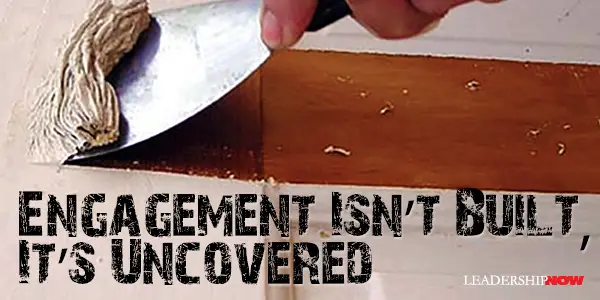
W But over the years, depending on our upbringing, our schooling, and our work, our desire to engage gets suppressed. It gets covered up. Our job as leaders is to uncover and rekindle that child-like desire to engage with others and our environment. We can’t create engagement, but we can uncover it. I was reading a remarkable little book written for teachers by retired professor Calvin Luther Martin entitled, Successful College Teaching Begins with Throwing Away Your Lecture Notes. We can learn a lot here because teaching, like leading, is about serving others while achieving a result. Indeed, teaching is a function of leading. We teach much more than our subject matter; we teach trust or distrust, courtesy or discourtesy, warmth or coldness—the lessons between the lines. The people we lead are not coming to us from our perspective. They have their own that has been years on the making. Bear in mind that you are teaching young men and women with an educational past that has shaped them. We bring our whole selves to work. Our hope, our scars, our dreams, our fears, our expectations, and our assumptions. Our childhood sense of wonder has been abused. It’s there, but it is cautious. We are conditioned to want to be right more than we want to be accurate. Behold the class before you. They are not blank slates, nor are they ignorant. There is plenty written on those slates and your task is to rewrite much of that text—if they will trust you and if your good enough to get that close to them. They sit before you, thoroughly trained (brainwashed might be a better word) in ways of pedagogy that will determine how they hear you, what they hear and cannot hear, and how they will absorb what you say. We are not leading another version of us. We are leading a human being similar in form but different in substance. These people come to you with layers of expectations that have been created starting in the first grade. Like an old kitchen countertop, they have been painted over and over. The oak, cherry, or maple cabinet beneath is smothered by an amour of paint. It’s a bland countertop now. The fine wood underneath is unknown; it’s merely a rigid structure useful for covering with paint and, after that, supporting pots and pans. A leader has to peel off the old paint and get to that desire to engage that has been unwittingly covered over. We have to uncover the desire to engage. The desire to learn. The desire to connect. The tendency is to be instructing. We do need to instruct but it needs to be part of a larger, coherent story that people can feel a part of. We are wired to engage. It’s already within us. Our task as leaders is to uncover what is already there. Martin explains that to teach or to lead “is to give a concert, to perform a beautiful, passionate concerto which everyone in the audience yearns to play, improvise on, and even improve.” We don’t build engagement, we uncover it. Uncover engagement in your organization. 
Posted by Michael McKinney at 07:01 AM
06.08.18

Reinforcements: How to Get People to Help You
“I actually felt as if I was going to perish,” said psychologist Stanley Milgram upon asking a subway rider for their seat. Asking for help makes most of us uncomfortable and we often go to great lengths to avoid doing it. We fear rejection. We fear that people we think less of us. We believe people don’t really want to help. But the truth is we need the help and support of others to succeed. To be sure, leadership is fundamentally about asking people for help. “Reaching your fullest potential—professionally or personally—requires you to understand how to enlist reinforcements when you need them. For many of us, ‘when you need them’ is literally every day,” writes Heidi Grant in Reinforcements. Yet our reluctance to ask for help means we often don’t get the support or the resource we need. Making matters worse, our intuitions about what should make others more likely to help are often dead wrong; our fumbling, apologetic ways of asking for assistance generally make people feel far less likely to want to help. We hate imposing on people and then inadvertently, we make them feel imposed upon. We underestimate our chances of getting help, especially from those that have said “no” once already. We don’t like saying “no.” We don’t think less of people when they ask us for help. But for some reason, we forget that when it is our turn to ask for help. Research shows that people actually like us more when they have been able to help us. It makes them feel good too—unless they feel compelled to help. Asking someone, “Can you do me a favor?” increase the likelihood that they’ll say yes, but usually because they now feel trapped. So what are the subtle cues that motivate people to work for us? Grant says, first of all, don’t make it weird by overdoing it on empathy (i.e., ASPCA commercials), apologizing profusely (just ask), using disclaimers (“I normally wouldn’t…”), emphasizing how much the other person will love helping (“This will be fun!”), and reminding people that they owe you one, among other tactics. Instead try these three ways of asking others for help: In-Group Reinforcement Those members of our group are the most likely to help us. To create a sense of in-group among people, use the word “together,” create or highlight shared goals, identify a common enemy, share common emotions, experiences, and feelings. The Positive Identity Reinforcement Most people like to think of themselves as helpful because it is part of what it means to be a good person. We reinforce that with gratitude and appealing to the things that matter to them. “To maximize positive identity reinforcement, know your audience and emphasize what matters to them, not to you.” Gratitude is a glue that binds you and your benefactor together, allowing you to hit the same well over and over again when you need support, know that it won’t run dry. Also, “the more unique the help, the more closely tied it is to who they are.” If people feel that anyone could help you, it is more likely that they will pass thinking that someone else will help. They need not bother. “To activate the positive identity reinforcement, find ways to convey that the helper is in a unique position to help you.” “You’re my only hope.” The Effectiveness Reinforcement People want what they do to make an impact—to have meaning. If we feel we are not making an impact, we are likely to lose motivation. People need to clearly understand the impact of their helping. Research shows that when people are unable to get any kind of feedback about how well they are doing on a task, they quickly become disengaged from it. The question is, “How do I know what I am doing is important?” “How do I know that my time, money, or effort wouldn’t be better spent some other way?” Be clear up-front about what you want done and the impact it will have. And be sure to follow-up. Let them know how things turned out. As a leader, “helping people see the impact of their work—their help—is one of the most important motivators you can wield.” Reinforcements is written in an engaging way and is full of solid research to support the approach needed to get the help we need to succeed. It is practical advice for anyone asking for help in a way that will leave both parties feeling good about the relationship. 
Posted by Michael McKinney at 07:41 AM
11.04.13

Xceptional Execution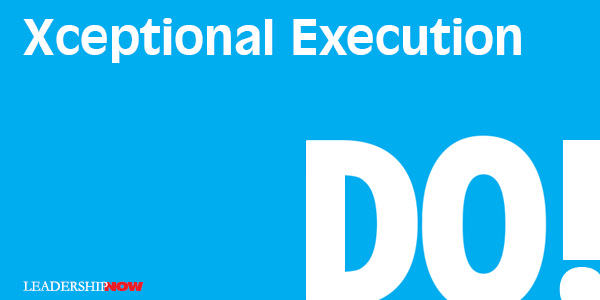
YOU DON'T need to be a guru. You don’t need to be rich. You don’t need to invent the next big thing to be a success. What you need to do, says Kevin Kelly is find an ordinary idea and implement that idea with xceptional execution. You can start with what you have from where you are. The list of reasons why we shouldn’t do something is often long and persuasive. We are predisposed to accept it. And so we let our ideas die. The combination of fear and knowledge is all too often lethal to our best ideas. Kevin Kelly writes in DO! The Pursuit of Xceptional Execution, “the antidote for too much knowledge is execution. Why? Execution helps to work through fear and build confidence. Knowledge will always give you enough reasons not to act. Execution is taking the next step in spite of that knowledge.” Have you ever seen someone doing something that you’ve always wanted to do even though you know they should know better? And yet they’re doing it and you’re not. Maybe it should be, “Those who know teach, those who don’t do.” Too much knowledge can be a dangerous thing.This doesn’t mean that we jump into something without thinking. That’s unwise. Kelly says execution rests on two pillars: Awareness (Self) and Attention (Others). Part of awareness is being able to receive negative feedback, learn from it and apply it in a way that you grow. Anyone you come into contact with is a potential teacher. Kelly says, “You will find that there are zero degrees of separation from potential teachers.” One of the things that holds us back is not that we can’t solve the problem, it’s that we don’t see the problem. Who we are is obvious to others—our co-workers and customers. You’ve got to know what you are projecting to others. The other pillar is attention. “People crave genuine, authentic, undivided attention, the side effect of which is extremely positive: loyalty, engagement and positive word-of-mouth promotion.” Kelly advises that we “focus on building friendships, not customer relationships.” We don’t always know exactly what to do or where we are going, but Kelly insists that the xceptional execution ethos will take you places you never imagined. Xceptional Execution = Opportunity. Kelly talks to nine xceptionalists to understand their story—how they did what they did and how they executed in spite of the ups and downs. Throughout these examples will find mindsets and actions that resonate with your own situation. DO! will expand your mind and broaden your approach. 
Posted by Michael McKinney at 04:32 PM
08.15.13

9 Tips to Avoid Getting Sidetracked
TOO OFTEN WE think we know exactly what is going on in our minds and what is affecting our behavior. Even though we are committed to our plans we find that the end result bears little resemblance to our best intentions. Somehow we get sidetracked. We face internal pressures, relational pressures, and external pressures to take us off course. These pressures keep us from being consistent with our self-image as capable, competent, and honest individuals. In Sidetracked, Francesca Gino has highlighted nine reasons we get sidetracked—why our decisions get derailed—and provides solutions to avoid them. Here are nine tips to avoid getting sidetracked:Raise your awareness of the subtle influences on your decisions. For instance, our biased views of how competent and capable we are can make us unwilling to listen to the opinions of others. We tend to value expensive advice over inexpensive advice. Take your emotional temperature before you make a decision to see if an unrelated event is affecting the decision at hand. Our moods affect our decisions. Ask, "Is this emotion clouding my judgment?" The emotions we experience while implementing our plans can sidetrack us. Zoom out to include more information when making our decisions. Ask: "Why did I choose the information that I did?" "What information am I missing?" "What was my initial plan?" and "Why did I embark on this course of action?" Take the other party's point of view. We tend to overestimate the extent to which others share our attitudes and feelings, to believe that others have more access to our internal states than they actually do, to use ourselves as a standard when evaluating others, and to draw on our own experiences when anticipating how others will evaluate us. What seems obvious to us is not always obvious to others. Question your bonds—your links and similarities—to those around you and consider whether these bonds may be influencing your decisions for the worse. The behavior and decisions of others not only affect the decisions we make but the conclusions we reach about other people. “We don’t have a stable moral compass.… What I’ve found in my research is that it’s easier to pick up the unhealthy habits of others than to be swayed by their good behaviors.” Check your reference points to consider the motives—social comparisons and emotions—behind your decisions. "The way we define and understand ourselves is an inherently social process….Our decisions are biased by the comparisons we strategically choose in order to alter how we see ourselves." By becoming more attentive to frames, we can become less influenced by them. Consider the source to determine if your judgment is warranted based on all the information available to you. Are you evaluating the right information? "We tend to "rely on irrelevant, but seemingly important, information when making judgments." Investigate and question the frame to see its impact on our behavior or decision. A change in framing can cause us to accept or abandon our carefully thought out goals and plans. How we frame things dramatically affects our acceptance and commitment. In an interesting study the author and others conducted, they found that framing the orientation and training process in a way that encourages self-expression of personal identities and signature strengths produces beneficial effects for the employees and the organization—namely motivation and retention. Make your standards shine by putting them first and discussing them more often. Too often we just need the right opportunity to come up with a reason to reinterpret our behavior. 
Posted by Michael McKinney at 02:48 PM
05.08.13

How to Make Your Ideas Contagious
AS leaders we need to understand how to make our ideas catch on. This is most effectively done through word of mouth and social influence. It's more persuasive than advertising and is more targeted to an interested audience. Jonah Berger shares the science behind word of mouth in Contagious and even teaches a class at The Wharton School by the same name. Interestingly, most people think that most word of mouth happens online. But research finds that only 7 percent of word of mouth happens online. "Offline discussions are more prevalent, and potentially even more impactful, than online ones. Berger presents many examples of contagious ideas that seem clever in hindsight. And we can learn from these. From these examples and his own research, he has assembled six principles or STEPPS for making products, ideas, and behaviors more likely to become popular: Social Currency: We share things that make us look good. Find the inner remarkability that makes people feel like insiders. Give people ways to achieve and provide visible symbols of status that they can show to others. Triggers: How do we remind people to talk about our products and ideas? People talk about what comes to mind. Top of mind leads to tip of tongue. There is immediate and ongoing word of mouth. Movies benefit from immediate word of mouth, but many ideas and initiatives benefit from ongoing word of mouth. What keeps people talking? Triggers. Think context. Think about whether the message will be triggered by the everyday environments of the target audience. "A strong trigger can be much more effective than a catchy slogan." Emotion: When we care, we share. Naturally contagious content usually evokes some sort of emotion. Not all emotions are equal. Awe is good. Sad is not. High-arousal emotions—awe, funny, anger, anxiety—are shared more than low-arousal emotions like contentment and sadness. Public: Built to show, built to grow. Making things more observable makes them easier to imitate; products and ideas that advertise themselves. Practical Value: Products and ideas we can use. Highlight the value and package our knowledge and expertise so that people can easily pass it on. Stories: People don't just share information, they tell stories. Information travels under the guise of what seems like idle chatter. Embed your products and ideas in stories that people want to tell. The more of these principles you use the better, but not all are required to make your idea contagious. 
Posted by Michael McKinney at 11:49 PM
01.28.13

It’s Never About the Bike: A Lesson from Lance Armstrong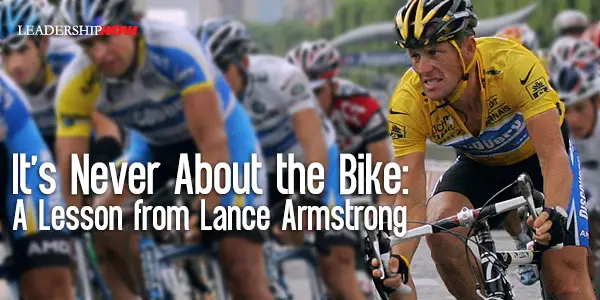
LANCE ARMSTRONG once wrote: “I believed I had a responsibility to be a good person, and that meant fair, honest, hardworking and honorable. If I did that, if I was good to my family, true to my friends, if I gave back to my community or to some cause, if I wasn't a liar, a cheat, or a thief, then I believed that should be enough.” Often we begin the race with solid values. We begin with values that drive our behavior based on intrinsic rewards. But over time, something can happen if we are not careful. Competitive pressures weigh on us. The chance for extrinsic rewards like money and power loom larger. If we have not built the strength of character to resist those temptations, we can easily become the person we don’t recognize.  The fact is, success changes nothing. Our legacy is built on the how not the what. It’s never about the bike. Without a strong hold on intrinsic values like humility, respect, truthfulness, patience and honor, we leave the door open for corruption and fraud. Changing what we value, changes everything. More to the point, it changes the choices we make. Choices build the life we lead and the legacy we leave. When it’s all about the win, we lose. Good values and solid character build a firm foundation for wins that can’t be taken away.  
Posted by Michael McKinney at 11:09 PM
04.09.12

All In: It’s Culture that Drives Results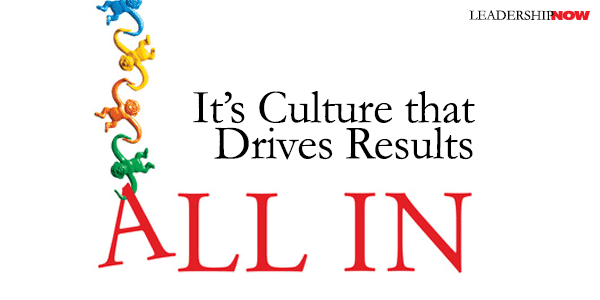
IN THE New York Times, Stephen I. Sadove, chairman and chief executive of Saks Inc., explains that it is culture that drives results: It starts with leadership at the top, which drives a culture. Culture drives innovation and whatever else you’re trying to drive within a company — innovation, execution, whatever it’s going to be. And that then drives results. While we know that our most important resource is our people, it’s not so easy to get people “all in”—convincing people to “truly buy into their ideas and the strategy they’ve put forward, to give that extra push that leads to outstanding results.” All In by Adrian Gostick and Chester Elton explains why some managers are able to get their employees to commit wholeheartedly to their culture and give that extra push that leads to outstanding results and how managers at any level, can build and sustain a profitable, vibrant work-group culture of their own. All In takes the principles found in their previous books—The Orange Revolution and The Carrot Principle—and expands on them and places them in a wider context.They begin by explaining that it all rests on the “belief factor.” People want to believe, but given the fact that “failure could cost them their future security why shouldn’t they be at least a little dubious about your initiatives?” But belief is key. “As leaders we must first allow people on our teams to feel like valuable individuals, respecting their views and opening up to their ideas and inputs, even while sharing a better way forward. It’s a balancing act that requires some wisdom.” To have a culture of belief employees must feel not only engaged, but enabled and energized. What’s more, “each element of E+E+E can be held hostage by an imbalance in the other two.” The authors have created a 7 step guide to develop a culture where people buy-in: Define your burning platform. “Your ability to identify and define the key “burning” issue you face and separate it from the routine challenges of the day is the first step in galvanizing your employees to believe in you and in your vision and strategy.” Create a customer focus. “Your organization must evolve into one that not only rewards employees who spot customer trends or problems, but one that finds such challenges invigorating, one that empowers people at all levels to respond with alacrity and creativity.” Develop agility. “Employees are more insistent than ever that their managers see into the future and do a decent job of addressing the coming challenges and capitalizing on new opportunities.” Share everything. “When we aren’t sure what’s happening around us, we become distrustful….In a dark work environment, where information is withheld or not communicated properly, employees tend to suspect the worst and rumors take the place of facts. It is openness that drives out the gray and helps employees regain trust in culture.” Partner with your talent. “Your people have more energy and creativity to give. There are employees now in your organization walking around with brilliant ideas in their pocket. Some will never share them because they don’t have the platform to launch those ideas on their own. Most, however, will never reveal them because they don’t feel like a partner in the organization.” Root for each other. “Our research shows incontrovertible evidence that employees respond best when they are recognized for things they are good at and for those actions where they had to stretch. It is this reinforcement that makes people want to grow to their full shape and stature.” Establish clear accountability. “To grow a great culture, you need to cultivate a place where people have to do more than show up and fog a mirror; they have to fulfill promises—not only collectively but individually.” And this has to be a positive idea. Gostick and Elton explain that the “modern leader provides the why, keeps an ear close to those they serve, is agile and open, treats their people with deference, and creates a place where every step forward is noted and applauded.” The authors skillfully examine high-performing cultures and present the elements that produce them. A leader at any level can implement these ideas to drive results. A great learning tool.

Posted by Michael McKinney at 11:46 PM
12.21.11

Doing More With Less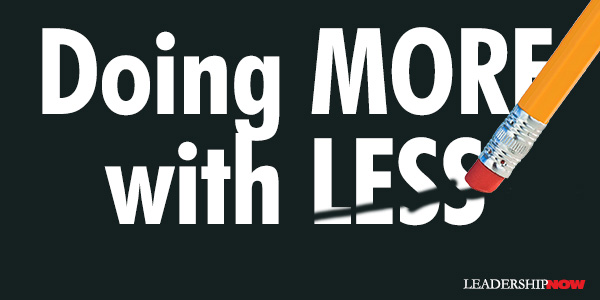 MOST companies are asking employees to do more with less. These demands may produce positive results in the short term, but they are not sustainable in the long term. “Organizations can do more with less simply by not leaving so much untapped performance on the table.” The frustration people often face in these conditions is not an engagement problem; it is more often an enablement problem.
MOST companies are asking employees to do more with less. These demands may produce positive results in the short term, but they are not sustainable in the long term. “Organizations can do more with less simply by not leaving so much untapped performance on the table.” The frustration people often face in these conditions is not an engagement problem; it is more often an enablement problem.
Mark Royal and Tom Agnew of the Hay Group, explain that The Enemy of Engagement is frustration caused by a highly engaged employee’s inability to succeed in a role due to organizational barriers or the inability to bring the bulk of his or her talents, skills, and abilities to the job. Ironically, the more engaged they are, the more frustrated they get because they care more. Doing more with less doesn’t mean conjuring higher levels of motivation out of thin air, but rather allowing motivated employees to perform at their best. It’s about harnessing and unleashing the full potential of frustrated employees—those who want to give their best but can’t due to organizational barriers and constraints. Typically we associate better engagement with leadership, but what drives it is better management. Fixing engagement means dealing with the frustration of thwarted employees. Specific management practices detailed by the authors include:
One of the most actionable things to do is to simply ask: “How can we change things around here to help you be more effective?” By doing so “a manager creates an opportunity for an employee to speak honestly and openly about enablement issues.”

Posted by Michael McKinney at 04:34 PM
12.20.11

5 Leadership Lessons: What if You Could Take Control of Your Life with One Decision?
 Many people are like garbage trucks. They run around full of garbage, full of frustration, full of anger, and full of disappointment. As their garbage piles up, they look for a place to dump it. And if you let them, they’ll dump it on you. So when someone wants to dump on you, don’t take it personally. Just smile, wave, wish them well, and move on. Believe me, you’ll be happier. Here are five lessons from David Pollay, to help us to focus on what really matters personally and professionally:

Posted by Michael McKinney at 10:43 PM
09.19.11

Hypocrisy Isn’t Going to Get You There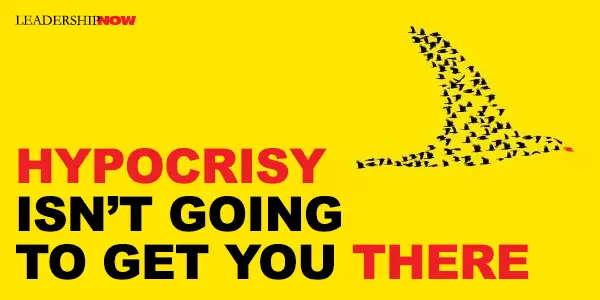
IF you’ve ever asked yourself, “What’s the matter with them? Why don’t they get it?” or said, “I feel like I am alone here,” maybe they are listening more to your actions than your words. Culture explains how things really work. Culture reflects practical values—values that will get you through the day regardless of what you say you believe. When it comes to preaching values, too many leaders are just talking heads. Preach change, demonstrate status quo. Changing culture in an organization is often difficult because leaders make it so. A culture that does not resemble your stated values reflects a lack of ownership and accountability to those values. A value that is meant for “them” but not lived-out in the behavior of and choices made by the leadership, will never become part of the organizational culture. Culture is formed by the choices we make, not the lecture we give. In Too Many Bosses, Too Few Leaders, Rajeev Peshawaria suggests three steps to cultural change: • Define the desired culture. Articulate a set of behavior guidelines for everyone to follow.
In this discussion he makes three statements that are worth reflecting on: Leaders should use every opportunity to exhibit guidelines or values in their own behavior. Are you modeling the behavior you want to see in others? Senior leaders of the company routinely showed up at these training sessions to show employees how important the values and brand were. Are you excusing yourself from what you expect others to be doing? In sharp contrast, another client told me to design the session in such a way that it did not rely too heavily on the executive team’s presence. He argued that the senior team was already under a lot of pressure, and that this would be a huge time commitment for them. I could not believe my ears. After all, as leaders, what do you spend time on if not aligning your organization’s culture with your vision and strategy? Do you live by a different set of rules? Sometimes this is difficult to see in yourself, so asking a trusted friend if there is a disconnect between your words and your behavior is helpful. As a leader, it is too easy to think of yourself as the exception. “I’m busy.” “They don’t have to deal with what I am dealing with.” “This is for them, I don’t need it. When a leader’s behavior conforms to their talk, there is a connective quality formed that is worthy of trust and attention. If we live our values we can create radical change.

Posted by Michael McKinney at 07:07 AM
09.13.11

Ownership Thinking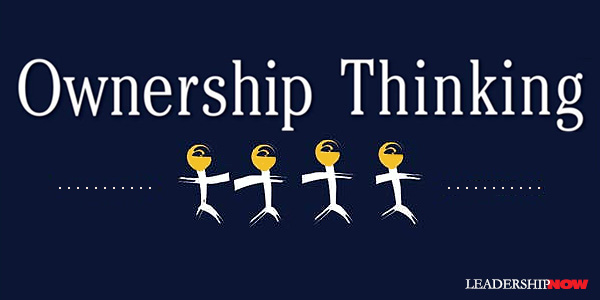
Ownership Thinking is about developing leaders at all levels. “Fundamentally,” writes author Brad Hams, “Ownership Thinking is about moving employees away from the ‘me’ way of thinking and towards concerns of the business and its financial performance.” This is leadership thinking in a business setting. When people understand the business, their role in it, and are informed of what is going on and take responsibility for the outcomes, then they become better stewards of the company’s resources and help to create wealth. Hams has found that the vast majority of people “want to engage and contribute, and feel much better about themselves when they have the opportunity to do so … and they have the capacity to do so.” We often frustrate that effort and create cultures of entitlement because, in the words of Judith Bardwick author of Danger in the Comfort Zone, “managers are unwilling to do the work of requiring work.” Hams says his mission in life is to eradicate habits of entitlement in organizations. People who actually produce things do so primarily for two reasons: (1) They have a strong work ethic. In other words, they have to believe that rewards come only with hard work, and (2) They enjoy producing. It is exciting for them, and the reward for producing is not only the things they are able to afford as a result of it, but the personal growth and sense of worth that come from producing: that is, true self-esteem. A workforce that is helping to create wealth should be able to participate in the wealth they are creating. However, incentive plans should be self-funding, and “it is the obligation of ownership and leadership to teach them how to do that and to provide them with the tools and training necessary to accomplish the task.” Simply put, your employees need to know what’s going on. In a chapter entitled, Your Employees Think You Make Wheelbarrows of Money, Hams relates that when he asks the question: “Your company had 12 million in sales last year, what do you think the profit was?” it is not uncommon to hear 50% from employees of companies where financial information is not shared or business acumen taught. “In the absence of information, people make stuff up.” Generally speaking, the people with the greatest understanding and expertise in any given area are the people who are actually doing the work, and these people are not necessarily management. For an organization to achieve excellence, it must engage all of its organization members. Ownership Thinking is a how-to book. Hams explains how to create incentive plans that work (plans that clearly align employees’ behavior to the organization’s business and financial objectives), how to teach financial skills (how the company makes money and how they add - or take away – value), creating the right performance indicators, rapid improvement plans and how to implement Ownership Thinking for the long-term. “Practicing Ownership Thinking will allow you, as an owner or leader, to rest easier knowing that your employees are making decisions and taking actions that are aligned with what you would do yourself.” 
Posted by Michael McKinney at 10:40 AM
08.08.11

Common Purpose Leadership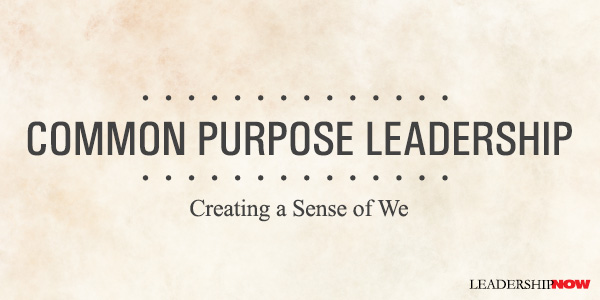
IN Common Purpose, consultant Joel Kurtzman makes the case that excellent leaders build a sense of inclusiveness—a sense of we—within the organization by creating a common purpose. A place where people know what to do and why and understand what the organization stands for. Based on interviews and first-hand experience, Common Purpose lays out how to achieve and then sustain a culture based on a common purpose. For example:
The easiest way to create a sense of we, says Kurtzman, is unfortunately to create the specter of them. Because it is easy, it is probably the reason you see this dynamic played out in so many organizations of all kinds. While it is a shortcut to common purpose, “it can also be a stepping stone to chaos, doom, and organized opposition.” I would add that within the organization or group, it also leads to arrogance, stagnation and closed minds. In most cases, it leads to decline. Organizations are created to achieve goals that “are beyond the capability of an individual to accomplish alone.” They are a method of “aligning groups of people so they achieve common goals.” This is best accomplished when you encourage people to be leaders at any level within the organization. Simon Cooper, president and CEO of Ritz-Carlton, says the best reason to rid an organization of mindless hierarchy is to provide scriptless service: employees deciding on their own how to make guests happy. “They make decisions on their own, on the spot, using their own judgment, and with the sense of confidence that comes from owning their jobs. That’s real leadership.” Taking risks on behalf of the organization. This requires trust at all levels and a different view of real leadership, says Kurtzman. It is difficult to overstress how important it is for teams of people working together to meet informally from time to time…The point is that you cannot lead a team if you do not know the people you are leading, and the best way to do that is informally. “The leader is not separate from the group he or she leads. Rather, the leader is the organization’s glue—the force that binds it together, sets its direction, and makes certain that the group functions as one.” Kurtzman notes, “Leadership is not coaching. Coaching focuses on helping people arrive at their own goals. Whereas leadership, especially common purpose leadership, is about helping people arrive at a collective set of goals. It is about coordinating people’s efforts, aims, ambitions, and capabilities.” Leaders can’t think of themselves as better than their workers or more favored because they have a higher rank. Becoming CEO is not a coronation; it’s a promotion. And CEOs can’t do everything. The purpose of an organization is to combine the efforts of many people to produce results no one on his or her own could achieve alone. Leaders must understand that. They must live the goals they espouse. They must understand that everyone inside the organization is looking at them — scrutinizing them, really — and also that every action of theirs is being watched and talked about. At FM Global, Shivan Subramaniam, the chairman and CEO, decided against buying a corporate jet despite the prodding of his board. Instead, he decided to abide by the same corporate travel rules that every other executive in the company abides by. He even flies on the redeye if he must. By doing this, he sends a powerful signal throughout the company that while he may be the CEO, he’s also an employee, just like everyone else. People value that. People will do almost anything for a leader like that. Of course, one size does not fit all. “People are individuals, and those who thrive in one firm might not thrive in another. Chemistry, fit, values, and many other qualities are in the eye of the beholder.” Kurtzman believes that “organizations will come to resemble constellations of capabilities linked together technologically from centers located around the world….Big companies will comprise smaller pieces, each with unique characteristics, ownership structures, and relationships. Each of these elements, when combined, will create enormous value?” The question is what will keep it all together. Incentives alone won’t do it. “The power of a common purpose will become the factor that differentiates winning organizations from those left behind.” This means that leaders will have to be “kinder, more caring, and more empathic than leaders of the past.” We have seen this increased focus on respect as many of you write, talk, and practice this on a daily basis. Common purpose leadership, at its most basic level, is about recognizing people as individuals. Common purpose leadership begins with respect for individuals and their differences, and goes on to celebrate their strengths. 
Posted by Michael McKinney at 10:59 AM
06.16.11

To Focus on the Work, You Must Focus on People Doing the Work
Many managers think they manage the work. They don’t. They’re responsible for the work, but they get work done by influencing the people who do the work. What makes this complicated is what Peter Drucker pointed out: when you hire a hand, it comes with a head and heart attached. So you must pay attention, lots of attention, to the whole person—head and heart—because you need more than your people’s time and attention. Most work now requires knowledge, judgment, thinking, and decision making, and so it matters if people care about what they do. You cannot simply give them orders and criticism. That rarely produces the kind of engagement you need. Other, less direct but more effective forms of influence—such as support, development, and encouragement—are needed that engage the whole person. Do you tend to focus on the work or on the people doing the work? In other words, do you tend to confront and criticize, or do you support people and give them what they need to do good work? Adapted from Being the Boss: The 3 Imperatives for Becoming a Great Leader by Linda A. Hill and Kent L. Lineback. 
Posted by Michael McKinney at 05:45 PM
01.28.11

10 Ways to Make Others Shine Earl Miller, a neuroscientist at MIT says, “Success has a much greater influence on the brain than failure.” Ned Hallowell comments in Shine: While of course mistakes need to be acknowledged and, one hopes, learned from, it may be more likely, from a purely neurological point of view, that a person will learn more from a success than a failure.” Earl Miller, a neuroscientist at MIT says, “Success has a much greater influence on the brain than failure.” Ned Hallowell comments in Shine: While of course mistakes need to be acknowledged and, one hopes, learned from, it may be more likely, from a purely neurological point of view, that a person will learn more from a success than a failure.”
Hallowell points out that acknowledgment or recognition serves two important functions. Of course there is the familiar purpose of giving the recipient encouragement, motivation and greater confidence, but recognition also promotes moral behavior through connection. Hallowell explains: “When a person feels recognized and connected to the larger group, she knows viscerally, not just intellectually, that she has made a contribution others value. Not only does this motivate her to do more and try harder, but it instills a desire to look out for the larger group…. It leads a person to do the right thing even when no one is looking.” Showing appreciation and giving recognition is part of the Cycle of Excellence process he calls shine. In our busy culture it is easy to overlook opportunities to acknowledge others. Noticing the positive is a daily challenge. In Shine, Hallowell offers these ten tips for promoting shine with the people you influence:
How do you make others feel valued? Related Interest:
Posted by Michael McKinney at 12:06 PM
12.13.10

Bury My Heart at Conference Room BIn Bury My Heart at Conference Room B, Stan Slap cuts through a lot of the dancing around that occurs in many leadership discussions.It should go without saying that emotional commitment improves organizational performance. If in doubt, Slap spells it out in the first third of the book. The way to get that emotional commitment, says Slap, is for you to live your own deepest values in your work environment. While any organization should encourage this, most often they don’t. “What companies want most from their managers is what they most stop their managers from giving. What managers want most from their jobs is what they most stop themselves from doing.” So, it’s up to you. The process of managing this tension what Bury My Heart is all about. The underlying problem is this: Companies can’t get emotional commitment from their managers because the company believes it needs to be the dominant organism in the relationship, which causes managers to have to repress their own values—and so causes them to detach emotionally from their jobs.Fear drives this tension: Are we going to survive as an organization if we are not in control? Slap says the only sustainable solution is leadership. “Leaders are people who live their deepest personal values without compromise” and because they do, “they’re essentially self-medicated—the pressure’s off the company to provide the deepest motivational fulfillment.” Slap insists that this isn’t licensing chaos but insuring control. Paradoxically, “there is no more reliable way for the company to become the cause than by not always insisting on being the cause.” Allow people to live their values at work. This isn’t a self-indulgent free-for-all. “Freedom to pursue your values come with responsibility to protect the company’s values.” It becomes an issue of trust between the organization and the individual. “Your job as a manager requires achieving results through others. Leadership is the single best method to do that. As long as your vision doesn’t violate the basic objectives and principles of your organization, those results will be hard for anyone to argue with.” Your leadership begins by understanding your own values—what is important to you—so you can sell those values to others. Beyond envisioning a “Better Place” of your creation, the people you lead have to see it too. What does life look like for them in this Better Place? Help them to get what they want as they head toward the Better Place. Slap writes: = Live better. If they believe it, they’ll do it. Of course, not everyone you lead will have the same values as you, but if you have communicated them well, “they’ll support yours if yours have positive impact for them.” Leadership happens to you as soon as you understand your own values and understand how to enroll others in supporting them. Instead of waiting for a leader you can believe in, try this: Become a leader you can believe in.
Posted by Michael McKinney at 11:47 PM
10.29.10

It’s a Jungle in There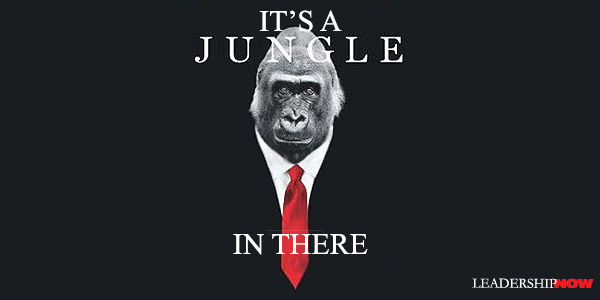
ANYONE that has ever been to the Rainforest Café, knows it's a treat. Created by Steven Schussler, the Rainforest Café holds the record as one of the top-grossing restaurant chains in the world and was the first restaurant concept to be featured at every Disney theme park worldwide. Schussler shares in It’s a Jungle in There, what it takes to make it happen and the lessons he learned that can be applied to your dream. Schussler embodies the five Ps of successful entrepreneurship—Personality, Product, Persistence, People, and Philanthropy—that he teaches in the book. He writes, “As a leadership quality, one’s own passion is what galvanizes others into action.” Passion and persistence has played a big part in everything Schussler has done. It’s “not going through the motions but going through with the emotions.”
“In the bedroom, my bed was constructed to look like it was suspended in a tree….Birds and animals moved freely through the area during showings of the house….Every room, every closet, every hallway of my house was a ‘scene’: an attempt to present my idea of what a rainforest restaurant would look like in actual operation….No venture capitalists were going to invest their money in my far-out concept without actually seeing it, so I transformed my house into my vision of what a rainforest restaurant would look like in order to make them believe in my dream.” Naturally, this would catch the attention of your neighbors (and law enforcement) too. There were problems of all sorts as you can imagine. And Schussler writes, “Being passionate doesn’t totally shield you from moments of doubt.” But his passion finally won out. How far are you willing to go to see your dream realized? In short, high-content chapters, he explains his guiding philosophy and backs them with concrete experiences. He has two quotes framed on the wall over his desk: “When you’re out of quality, you’re out of business” and “The noblest search is the search for excellence.” He talks about looking for “enhancement gaps.” Those gaps between “what you are seeing and what you could create to make what you are seeing better by providing some product or service.” He asks, “Are you willing to help other people succeed even when it’s not a requirement of your job to be of assistance?” Self-control: “What you don’t want to do is say things and/or act in a manner that will create negative impressions and the unwanted consequences that are certain to follow.” You must know your audience. Burning Bridges/Writing People Off: Don’t do it. “What I learned that day reconfirmed my belief that ego can be a killer, especially an unchecked ego. Most entrepreneurs need to have a healthy ego, but you also have to be realistic. That’s a very delicate balance—the kind of balance you need to cross a bridge you tumbled off the first time around.” Anyone would benefit by reading and integrating the lessons offered here. 
Posted by Michael McKinney at 03:13 PM
04.28.10

We Have Met the Aliens and They Are Us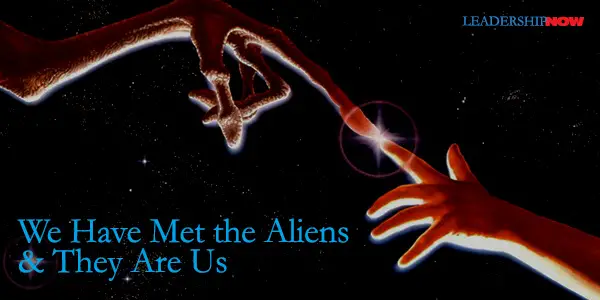
WE live in a time—aided by advances in science and communication—that is obsessed with quantifying, labeling and optimizing. Generational studies are no different. While identifying and labeling the generations is valuable for understanding and discussion, if we are not careful we can lose some connection to their humanity—their sameness. While generational studies can help us to understand where people are at, if want to engage them, we would do well to remember what they are. A generation comes and a generation goes. Each carries with them their own reaction to the former generation that raised them and their own disbelief of the reactions of the next generation to their own. Yet, each generation is not a new subset of humans; a curious new life form that needs to be studied and obsessed over. They are human. They are like us. "That which seems the height of absurdity in one generation often becomes the height of wisdom in another." We do a disservice to any generation when we coddle them and commoditize them. What generation doesn’t want everything just right? But life doesn’t work like that. Our ideals keep us pushing on, exploring, reflecting, and innovating, but our disappointments and the imperfections we uncover, help us to learn compassion and build character. Every generation has difficulties to overcome and excesses to curb. Every generation is faced with the prospect of growing up. And each generation does it from a different perspective. A perspective that they gained from their observation of those that came before them. And they will hand a different perspective, a different emphasis, over to those that come after them. "Parents often talk about the younger generation as if they didn't have anything to do with it." Like us, they are reacting to their upbringing and the world it created and bringing with them an attempt to find some greater idealism. Similarly, they need to learn balance, curb excesses, and rediscover forgotten behaviors and values. They need to learn compassion, the freedom that comes from admitting that you don’t know it all, and the value in what has come before them. No one generation excels completely in all things. All have different pieces of the life puzzle. All begin by placing a different weight on what is important and need to work to find the balance that makes their life more complete. We all share a humanity that spans generations. Human nature doesn’t change. Not everything the previous generation did was bad. Often it was good and necessary, but was executed poorly. We can be thankful that while previous generations were concerned with “work-life balance,” they decided they had better keep their focus on the tiller so that we would have the opportunity to run on the deck, criticize their methods, and endlessly debate whether or not the figurehead represents us well. "When I was a boy of fourteen, my father was so ignorant I could hardly stand to have the old man around. But when I got to be twenty-one, I was astonished at how much he had learned in seven years." A study of generational differences, more than anything, helps us to understand the consequences of our behaviors. What has worked and what hasn’t. Why an over-emphasis on this causes a problem there. If we can learn from it, we profit. However, our natural reactivity causes us to not learn as we should or build on the lessons of those that came before us. Human beings are not hard-wired with the lessons learned from the previous generation. So we all start at the beginning—learning and relearning—in the context of the world we find ourselves in. Each generation must come to the same place at the end of their lives as the one before it. All need to grow up. We need to become practiced at learning from each other; valuing each generation for where they have been, what they are learning, and the perspective they bring. In a more connected world, the consequences of our behavior are greater. We have more reach. What we do affects more people and for longer periods of time. This creates a critical need for wise leadership. Each generation will rewrite their world. Their thoughts and ideals aren’t new. Their emphasis is. “Treat Millennials with respect and dignity. Don’t over-manage them. Make them feel included.” Really? This isn’t generation-specific. We all desire those things. Generational analysis also reminds us that not everyone sees things the way we do. “By understanding other generations’ perspectives,” writes Tamara Erickson in What’s next, Gen X?, “we are better able to position our ideas and requests in ways that are likely to have positive results and avoid at least some of the frustrations of today’s workplace.” There are many good books in print that help to highlight the challenges that current generations face, their perspectives, and how we might learn from each other, and offer points of connection to help bridge the gaps. Here are several:
All generations face the same human issues but from different perspectives and with different tools. But they all look for connection, meaning, and contribution. They all want to add value and feel the satisfaction of a job well done.
Posted by Michael McKinney at 01:28 PM
04.26.10

Leading Outside the Lines: Mobilizing the Informal OrganizationRight now, the informal elements of your organization are either working for you or against you. Yet for most leaders, say Jon Katzenbach and Zia Khan, authors of Leading Outside the Lines, the informal organization is poorly understood, poorly managed, and often disregarded because it is too hard to think about.The formal organization has its own way of attracting, selecting, developing, and rewarding people—but it rarely has the power to affect promotion or compensation. Therefore, those who rise to influential positions in the hierarchy are more likely to be more comfortable with and skilled at using the formal organization than the informal….Informal leaders rarely have the kind of explicit qualifications that can be easily documented or communicated, much less evaluated.The informal organization lies in the human side of the enterprise and as most things that reside there, it is hard. Unlike the formal side with its top-down, rational approach, the informal is fuzzy, constantly changing and hard to measure. So it is understandable that we would like to somehow ignore it or work around it. But, “if you want your entire organization to improvise frequently and energetically in response to fast-moving change, formal management techniques alone won’t get you there. You need help from the informal side as well. Mobilizing the informal organization helps support formal management mechanisms, increasing their chances of success and deepening their long-lasting impact on the organization.” For leaders, the challenge is to find the balance between the formal and the informal elements of the organization in their particular situation, to achieve concrete, measureable results. When trying to make a change, our default tactic is to explain “in excruciating detail why the new plan is important.” We think if they get the logic of it, they will get behind it. But they often don’t. People need an emotional connection. Simply formalizing a new set of rules, programs, and structures will not pull the company's culture along. “To that end, leaders need to be able to translate vision, targets, and strategies into personal purpose, accomplishments, and choices that each one of their people can understand and feel good about pursuing.” The authors make the distinction that while the formal organization is best when dealing with predictable and repeatable work that needs to be done efficiently and without variance, the informal organization is best suited to unpredictable events—surprises that need to be sensed and solved. They add that in many cases, when activity in the informal organization starts to repeat itself, it “is a signal for broader changes that need to be made to the formal organization.” To move beyond “best practices” and the status quo—to get to “best performance”—a leader needs to learn to mobilize the power and plasticity of the informal. What You Can Do Now
Posted by Michael McKinney at 12:05 PM
02.08.10

12 Behaviors You Can Practice to Make You a More Inspiring Leader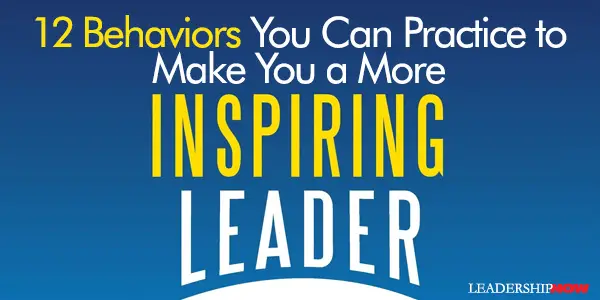
JACK ZENGER, Joe Folkman and Scott Edinger conducted a four year study of over 200,000 responses describing 20,000 leaders to determine what makes an outstanding leader. The results pointed to the fact that the ability to “inspire and motivate to high performance” was the single most powerful predictor of being perceived as an extraordinary leader. It was the best predictor of overall ratings of leadership effectiveness by direct reports, peers, and managers, it was the quality most valued by employees, and it was the factor most correlated with employee commitment and satisfaction. And it was found to be cross-generational. Inspiration, they point out in The Inspiring Leader, is not sufficient in and of itself. “Its power comes when it is placed in combination with other leadership attributes.” It works as a catalyst. Throughout the book, they discuss a large number of steps you should consider to become a more inspiring leader, but here is a selection of twelve behaviors that you can apply now:

Posted by Michael McKinney at 12:12 AM
02.05.10

Drive: What’s Motivating You?
WHEN it comes to motivation, I think we can all agree on one thing: People are motivated in different ways—often surprisingly different ways—at different times depending on their needs, wants, desires, philosophy, age, friends, status, values, circumstances, background, mood, attitude, insecurities, self-absorption, and a number of things I left out for the sake of brevity. Obviously, when it comes to motivation, one size doesn’t fit all, best practices don’t work across the board, and our approaches to motivation must begin with respect. In Drive, Dan Pink defines three types of motivational operating systems or assumptions about how humans behave from which a motivational construct can be created: Motivation 1.0 presumes that humans are biological creatures, struggling for survival.Motivation 2.0 presumes that humans also respond to rewards and punishments in their environment. It seeks compliance. Motivation 3.0 presumes that humans also have a third drive—to learn, to create, and to better the world. It seeks engagement. Listed the way they are, it is tempting to think of this as a historical progression moving from the base world of the caveman to the enlightened world of today. In fact, these types of motivation have been with us throughout history, however today we are blessed with the opportunity to contemplate Motivation 3.0 on a scale that was never before possible. And we should. The most important point Pink makes is that we still use Motivation 2.0 as a fallback motivational construct for almost any situation we encounter—and most often to our detriment. Stating the problem, he writes: Too many organizations—not just companies, but governments and nonprofits as well—still operate from assumptions about human potential and individual performance that are outdated, unexamined, and rooted more in folklore than in science. They continue to pursue practices such as short-term incentive plans and pay-for-performance schemes in the face of mounting evidence that such measures usually don’t work and often do harm. Worse, these practices have infiltrated our schools, where we ply our future workforce with iPods, cash, and pizza coupons to ‘incentivize’ them to learn. Something has gone wrong. Something has gone wrong—or—maybe has never really been sufficiently addressed. Carrot-and-stick motivators are much easier to implement than intrinsic motivators. Who has the time? But as work changes—“more complex, more interesting, and more self-directed”—intrinsic motivation is going to be a much larger, pressing concern to leaders. But, I think it would be wrong to assume that Motivation 1.0 and 2.0 are no longer of any consequence. We must recognize that people are at different places at different times in their lives. A person could even prefer Motivation 2.0 for their own 3.0 reasons. Extrinsic motivators have their place in many situations, especially when time is an issue. Although extrinsic motivators may be hit-or-miss, they often get the job done and they are fairly easy to implement in an even-handed way. The problem is that they are overused and often used exclusively. Extrinsic motivators are grounded in short-term thinking and will not provide lasting results. Unfortunately, we do create systems and workplaces that encourage behavior driven by extrinsic motivation that doesn’t satisfy our need for meaning. Extrinsic motivators will never give employees the autonomy, mastery and purpose that Pink calls for. Nor are they really designed to do that. They simply influence short-term behavior to a desired end. There are times when Pink’s research leads to overreaching conclusions, but his basic argument that we are designed to be “autonomous, self-determined, and connected to one another” and that “when that drive is liberated, people achieve more and richer lives” is a sound one. As he suggests, we should try to move people and work to a Motivation 3.0 construct that fosters what he terms Type I behavior. Type I behavior is “a way of thinking and an approach to life built around intrinsic, rather than extrinsic, motivators. It is powered by our innate need to direct our own lives, to learn and create new things, and to do better by ourselves and our world.” The last third of the book is a toolkit for fostering more Type I behavior. There are practical suggestions for the workplace, but some of his best suggestions are for parents and educators. If some of these ideas were put into practice, we would probably turn out more engaged kids, with critical thinking skills and a life-long love for learning. In all, Pink makes a good case for the adoption of Motivation 3.0 based on the widely accepted fact that work that makes us feel in control of our lives is better than work that doesn’t. Some work has the potential to do that and some work never really will. But, if Drive raises our awareness and causes us to re-examine how we are motivating people (or not) and the effects of the systems we create, then it will have made a serious contribution to making our organizations a better place to work and helping people to fulfill their potential. 
Posted by Michael McKinney at 07:38 AM
10.12.09

Can You Motivate Everyone?At the basis of motivation is the why of human behavior. The fact that there are so many methods used to encourage people to put forth their best effort, speaks to the complexity of the issue. But can everyone be motivated? The simple answer is no. You can’t successfully motivate everyone. And some might say you can’t motivate anyone. Motivation is an internal process. Much is dependent on an individual’s concept of themselves and their interpretation of the environment or situation they find themselves in.In Motivate Like a CEO, author Suzanne Bates reminds us that “you can inspire people to discover their own motivation. If you communicate effectively and connect people with purpose, they will feel the spark that motivates them.” Additionally, she writes, “By consistently communicating purpose with passion, you attract the right people with the right talent, skills, and motivation. The right people come into your orbit; those who aren’t right will move on.” At the same time, Bates does offer a caution. Throwing your hands up and acting on the assumption that you cannot motivate everyone can actually damage motivation further. This assumption was “true in boom times, when organizations were bloated and some people you hired were marginal. Those days are over. Now that companies have downsized and are arguably leaner and meaner with the best talent, this is a damaging assumption. It is a leader’s responsibility to motivate employees. It’s time to stop blaming employees, and start looking to leaders to ignite the spark.”
Posted by Michael McKinney at 09:37 PM
07.27.09

5 Leadership Lessons: Getting Your Relationships Right Townsend wrote Leadership Beyond Reason to help you understand and utilize the soft skills – that which is beyond reason. He says “you ignore what is beyond reason at your own peril….Leading from your inner world ultimately produces better results in your leadership.” He divides our inner world into five areas: values, thoughts, emotions, relationships and transformation. As leadership is about connecting with those you lead and a primary focus of leadership, let’s pull five lessons from Townsend on relationships: Developing your relational abilities will help you read the landscape. Townsend adds, “The leader who misses relational aspects is surprised when people become distant, resentful, or just leave. The relational leader sees the signs coming a long way away and has time to do something about them.”
Posted by Michael McKinney at 09:51 AM
03.09.09

Strategic Presence: The Power that Fuels LeadershipTony Jeary, author of Strategic Acceleration: Succeed at the Speed of Life, is a coach to some of the world's top CEOs. In his book he brings together practical ideas to help you get out of your own way. A critical aspect of getting things done through others is presence – your presence. To influence others you need to know how they perceive you and adjust your communication with them accordingly. Here, Tony discusses what he calls strategic presence:The goal of leadership is to produce superior results on purpose and that makes leadership a results contest. The challenge of leadership is to persuade and motivate those they lead to produce the results they want. When people voluntarily and enthusiastically do what their leaders ask them to do and the desired results are achieved, leaders are considered to be effective and successful! The question is how do leaders really get others to voluntarily and enthusiastically produce the desired results? There are many parts to this puzzle, but there is none greater than a condition I describe as Strategic Presence. Here is a great story that illustrates Strategic Presence and also illuminates its effect. A student from a foreign country was enrolled in the middle of a school year. During the first day of class, the other kids in the class were doing what kids do. There was a lot of giggling and staring and posturing for the new arrival. The new student was dressed in a way that did not meet the expectations of a few of the other children and eventually one of them (the class clown) began to make jokes about the new student's appearance. As the scene was progressing toward chaos, the teacher was about to intervene when a girl stood up and told everyone to stop picking on their new classmate. The girl reminded them that it was scary to be new in a school and they needed to be kind to the student and make them feel welcome She reminded them they should treat this new person as they would want to be treated if they were in a new country and a new school. After class, the teacher called the girl aside and said, "That was a very brave thing you did. Why did you do that?" The girl replied, "Because that is what my Mom and Dad would expect me to do!" This story powerfully illustrates the essence and the effect of what I call Strategic Presence. The girl had merely done what she knew her parents would want her to do. Her parents had succeeded in creating a positive presence in her mind, which gave her the willingness and courage to do what she did. Most importantly, the presence of her parents was so authentic that they did not have to be physically present to inspire their daughter's good behavior. Leaders create impressions that exist in the mind of every person they lead. It is a presence that defines the perceptions people have of their leaders and what they believe about them. It is this overall persona that I am referring to when I use the term Strategic Presence and there are two types: Positive and Negative. Leaders are constantly creating and presenting images of influence that produce both. The most important fact about Strategic Presence is that it produces two possible reactions in others. It either produces voluntary cooperation or it produces various forms of resistance. If leaders generate positive Strategic Presence, people will be more likely to support what they want, most of the time. However, if perceptions of leadership are negative people will substitute resistance for cooperation. The possibilities of how people will respond to Strategic Presence are limited to cooperation or resistance. There is not much middle ground between them. As someone once said, "you are either for us against us!" It is easy to see why creating an authentic, positive strategic presence is critical for the execution of a vision. Creating positive Strategic Presence is not a strategy of manipulation. The positive strategic presence leaders project must be authentic. Failing the test of authenticity means the very image leadership hopes to establish will be perceived as deceptive and disingenuous, or worse. People are very perceptive and they will see through efforts to project a phony persona for the purposes of manipulating their behavior. So, why shouldn't a leader's strategic presence just be allowed to be what it is?" That is a great question and the answer is simple. Many leaders are misunderstood and create perceptions that really don't match their intent. So, understanding how Strategic Presence is created will minimize the possibility of being misunderstood. So, how is strategic presence is created? What are the things about leadership that speaks the loudest about it? What creates the perceptions that combine to produce Strategic Presence? There are two components that contribute to strategic presence: values and behavior. Our values are established by what we believe to be right, wrong, true, false, acceptable, unacceptable, appropriate and inappropriate. Let's face it, we have all developed deep, strong opinions about many things as we live our lives. Our opinions spring forth from your values and your values influence what we actually do. Our values and beliefs impact 5 categories of that drive our behavior, and it is our behavior that creates Strategic Presence. The five categories that drive behavior are:
Posted by Michael McKinney at 05:54 PM
11.14.08

Hiring the Right Skill Set and Motivating the Millennials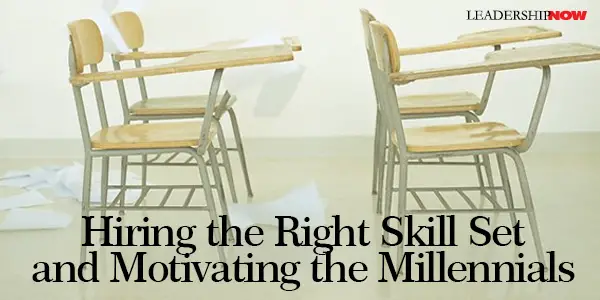
IN RAISING and schooling our children in the U.S., it appears we have dropped our standards. And it shows. Finding the right people is becoming a more and more difficult proposition. (I enjoyed reading about Linda Zdanowicz's search for a dental assistant on her blog.) Tony Wagner, author of the The Global Achievement Gap has written an important book that should not be ignored by business leaders. It sets a meaningful agenda for a good dialogue between educators and business leaders and concerned parents about our educational system. Wagner has written the following for us: In an economic downturn, employers need to be even more careful with their hiring decisions. And recent graduates from some of the best schools may not have the skills that matter most in the new global knowledge economy. In researching my book, The Global Achievement Gap: Why Even Our Best Schools Don’t Teach The New Survival Skills Our Children Need -- and What We Can Do About It, I have come to understand that there are "7 Survival Skills" for the New World of Work, and that employers must look beyond applicants' "pedigrees" to carefully assess whether they have the skills that matter most. New Skills Here are the Seven Survival Skills, as described by some of the people whom I interviewed: • Critical Thinking and Problem Solving "The idea that a company's senior leaders have all the answers and can solve problems by themselves has gone completely by the wayside . . . The person who's close to the work has to have strong analytic skills. You have to be rigorous: test your assumptions, don't take things at face value, don't go in with preconceived ideas that you're trying to prove." —Ellen Kumata, consultant to Fortune 200 companies
• Collaboration Across Networks and Leading by Influence "The biggest problem we have in the company as a whole is finding people capable of exerting leadership across the board . . . Our mantra is that you lead by influence, rather than authority." —Mark Chandler, Senior Vice President and General Counsel at Cisco
• Agility and Adaptability "I've been here four years, and we've done fundamental reorganization every year because of changes in the business . . . I can guarantee the job I hire someone to do will change or may not exist in the future, so this is why adaptability and learning skills are more important than technical skills." —Clay Parker, President of Chemical Management Division of BOC Edwards
• Initiative and Entrepreneurship "For our production and crafts staff, the hourly workers, we need self-directed people . . . who can find creative solutions to some very tough, challenging problems." —Mark Maddox, Human Resources Manager at Unilever Foods North America
• Effective Oral and Written Communication "The biggest skill people are missing is the ability to communicate: both written and oral presentations. It's a huge problem for us." —Annmarie Neal, Vice President for Talent Management at Cisco Systems
• Accessing and Analyzing Information "There is so much information available that it is almost too much, and if people aren't prepared to process the information effectively, it almost freezes them in their steps." —Mike Summers, Vice President for Global Talent Management at Dell
• Curiosity and Imagination "Our old idea is that work is defined by employers and that employees have to do whatever the employer wants . . . but actually, you would like him to come up with an interpretation that you like -- he's adding something personal -- a creative element." —Michael Jung, Senior Consultant at McKinsey and Company
Looking Beyond the Degree The conventional thinking of many who make hiring decisions is that graduates from "name-brand" colleges are likely to be more intelligent and better prepared than students who have gone to second or third tier schools. But, in reality, what the degree may mean is that these students are better at taking tests and figuring out what the professor wants -- skills that won't get them very far in the workplace today. A senior associate from a major consulting firm told me that recent hires from Ivy League business schools were constantly asking what the right answer was -- in order words, how to get an "A" for the job they were doing -- and were not always very adept at asking the right questions, which was the single most important skill senior executives whom I interviewed identified. So what does this mean for the interview process? First, listen carefully for the kinds of questions the applicant asks. Are they probing? Insightful? Do they suggest that the applicant has really prepared for the interview by trying to understand your business? Do you feel as though you or your company are being interviewed? If so, that's a very good sign. How a prospective employee asks these questions matters, as well. Does he or she listen carefully and engage you in discussions? Is the potential new hire both interested and interesting? In addition to the ability to ask good questions, senior execs told me that the ability to "look someone in the eye and engage in a thoughtful discussion" is an essential competency for working with colleagues and understanding customers' needs. Finally, perhaps the most important question you might ask is, "what do you want to learn or how do you want to grow in this job?" This question is essential for two reasons: First, the quality of the answer will tell you how reflective this individual is -- and how intentional he or she may about his or her own development. More than any specific skill, individuals must want to learn, grow, and improve continuously to be successful in today's workplace. Motivating the Millennials The second reason why this question is important goes to the heart of the problem of how to motivate new hires to do their best. In asking the question, "how do you want to grow," you are signaling to a prospective employee that you and your company are committed to developing the talents of your workers. Many employers worry that this generation lacks a work ethic. But in my research, I have discovered that this generation is not unmotivated but rather differently motivated to learn and to work. Above all else, they want opportunities to be challenged and to make a difference. Describing the different work ethic of this generation, Ellen Kumata, who is a managing partner at Cambria Associates and consults to senior executives at Fortune 200 companies, told me, "They don't see coming into a company as being a career experience. They don't want to climb the corporate ladder and make more money and please the boss. And so you can't manage them the same way -- you can't just put them into a cubicle and expect them to perform." Tracy Mitrano, who manages the Office of Information Technologies at Cornell University, agreed: "You have to make the work more interesting and allow them to work in different ways. They are prepared to work just as much and just as hard -- but not at a desk 8 hours a day." Andrew Bruck was finishing a law degree at Stanford when I interviewed him last year. "We want to feel ownership. We have a craving for an opportunity to do something really important," he told me. "People in my generation have been in a constant state of training. Now they're excited to go do something. The more responsibility you give people, the better they produce . . . There are more and more recent law school grads who are willing to take a lower salary in return for an opportunity for more meaningful work." Ben McNeely, a journalist, described to me the difference between his former employer and his current one. "At the paper where I worked previously, the publisher would kill stories if they portrayed an advertiser in a negative light. At the paper where I work now, I have an opportunity to contribute something in a growing community. I was brought in to cover the new bio-tech research campus under construction nearby, where the Canon towel factory used to be, and to cover health care issues, as well. I have support from the editor and publisher who both have strong journalistic ethics. I like it that the editor pushes Windham, who us to dig deeper." Carie Windham, who graduated from college in 2005, told me about the best boss she's ever had. "He asked me where I want to be in 10 years. He talked to me about creating the experience I want to have. He understood I wouldn't be there forever . . . Mentoring is a huge motivational tool, someone showing an interest in you and giving you feedback. We want to feel we have a creative, individual role -- that we're not just working on an assembly line. We want to feel like we have ownership of an idea." Hiring the right talent, then, is only part of the problem employers face today. Equally important is how businesses create challenges and learning opportunities that motivate the Millennials to do their best. Google, which had more than one million applications for 5,000 jobs in 2006, is the number one pick of a place to work for many of the Millennials. Listening to twenty-two-year-old Matt Kulick talk about his work, one begins to understand how profoundly many companies will have to change in order to attract and retain the best talent: "First, they (Google) share ideals that I believe in—open source software. And their products are solving important problems for people—doing good in the world. I believe in what they're doing—these values are very important to me. I wanted to help out, to make a contribution. The second reason I came to Google is because they give me the resources I need to accomplish major things that will really make a difference in the world. The third reason is the responsibility they give you from the day you start. It is a winning combination. It makes me happy to go to work every day."  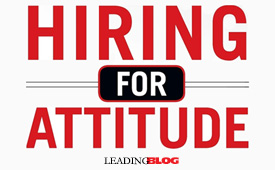 
Posted by Michael McKinney at 06:07 AM
03.19.08

The Lack of Connection Burns Us OutMichael Stallard's Fired Up or Burned Out, is a book that is worth returning to again and again. He writes that “connection meets basic human psychological needs for respect, recognition, belonging, autonomy, personal growth, and meaning. When these needs are met we thrive…. Conversely, the lack of connection will gradually burn us out.”As leaders our lives touch more people than we can imagine. It is here that we are either making connections with others or we are not. We are either contributing to engagement or burn out. Stallard believes that after we delete the things that devalue others like inappropriate criticism, micro-managing and allowing others who do to continue to do so, we need to dial up the value in at least six important ways:
Stallard writes, “Unless the people in an organization have a strong sense of connection—a bond that promotes trust, cooperation, and spirit de corps—they will never reach their potential as individuals, and the organization will never reach its potential.” Of Related Interest:
Posted by Michael McKinney at 11:17 PM
11.23.07

Why Leaders Don’t ComplimentIn Results that Last, Quint Studer lists six myths and excuses as to why too many leaders resist giving people much needed compliments.
Charles M. Schwab (1862-1939), founder of the Bethlehem Steel Company, said, “I have yet to find the person, however great or exalted his station, who did not do better work and put forth greater effort under a spirit of approval than he would ever do under a spirit of criticism.” In the often cited study by Gerald Graham, Ph.D. of Wichita State University, it found that employees consider personal, immediate recognition by their managers to be one of the most powerful workplace motivators. However, 58 percent of the respondents said their manager rarely, if ever, offered such simple praise. Graham concluded, “It appears that the techniques that have the greatest motivational impact are practiced the least, even though they are easier and less expensive to use.” Who should you be thanking?
Posted by Michael McKinney at 09:41 AM
11.21.07

How to Change Anything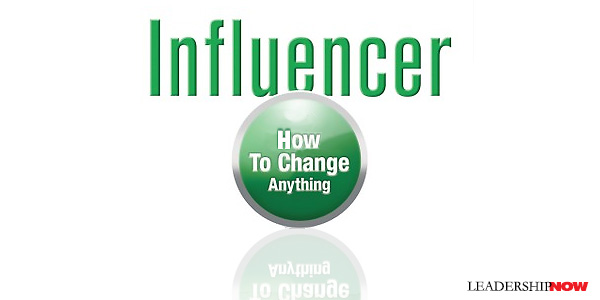
God grant me the serenity to accept the things I cannot change; courage to change the things I can; and wisdom to know the difference. THE authors of Influencer: The Power to Change Anything claim that they can show you how to change anything. Well, nearly everything. They suggest that most of the time we cop out. We comfort ourselves with the Serenity Prayer and move on. Maybe it’s not the courage we lack but the skills to change the things we can. The authors set about to do just that. “If you want to change the world, you eventually have to change how people behave. And if you want to change how they behave, you have to first change how they think.” The key idea is this: “A few behaviors change drive a lot of change.”What that means is, if you want to effect change, then while casting a vision is important (that is, what you want people to achieve), what you need to focus on is behaviors—what you specifically want people to do. If you determine the foundational behaviors upon which everything you want changed stands, and change those things, then everything else changes with it.
There is more than one way to influence and if you are only using one of them as a matter of habit, it may explain why you are having difficulty bringing complex and resistant problems to a solution. There are six sources of influence that drive our behavior divided between two domains—motivation and ability. They reason, “Virtually all forces that have impact on human behavior work on only two mental maps—not two thousand, just two. At the end of the day a person asks, ‘Can I do what’s required?’ and ‘Will it be worth it?’ Influencer presents a model that organizes influence in to 6 general strategies and clearly explains how to make use of these strategies in your own change issues.
Influencer is brought to you by the same group that produced such great books as Crucial Confrontations and Crucial Conversations: Tools for Talking When Stakes Are High. 
Posted by Michael McKinney at 11:53 AM
11.05.07

The Art of Winning Others Over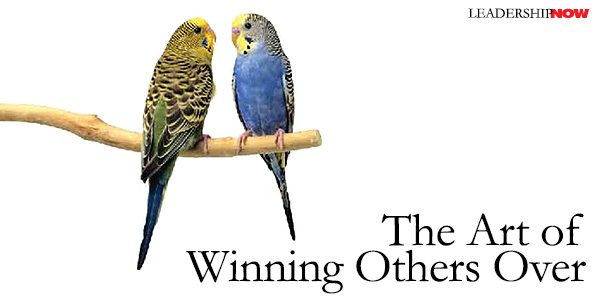
If there is any secret of success, it lies in the ability to get the other person’s point of view and see things from that person’s angle as well as your own. IN The Art of Woo or "Winning Others Over," authors Richard Shell and Mario Moussa, make the case that wooing is one of the most important skills in a manager's repertoire. Research would seem to support this claim as people with strong social skills have been shown to command higher fees and salaries than equally talented but less socially adept colleagues. And they are no doubt more pleasant to be around. Winning others over is an art. It is the ability to sell “your ideas to people within the context of ongoing, important relationships.” They maintain, “If you want to be a player in your organization, a successful partner with your customers or suppliers, a leader in your community, or even a good parent, you need to woo people to your point of view by putting your ideas across in convincing, relationship-friendly ways.” To that end, they remind us that the idea in persuasion is not to defeat the other person but to win them over. The place to begin is in understanding your own persuasion style. They have identified five types—The Driver, The Promoter, The commander, The Chess Player, and The Advocate—and have included a Persuasion Style Assessment to get you started. Whatever your preferred style tends to be, the idea is to strike a balance between what the authors identify as the "self-oriented" perspective-where focus is on the persuader's credibility, and point-of-view and the "other-oriented" perspective, which focuses on the audience's needs, perceptions, and feelings. They have created a systematic strategy or Woo Process, to aid you in skillfully getting your point across. In brief, they are: Step 1: Survey Your Situation, that is
They note that authority plays a background role in most interactions and while it can be useful in some situations, it should not be relied upon especially where there are multiple stakeholders. They say, “The formal roles people occupy are the starting positions for a complex dance of organizational influence.” They also note that actually, the higher up you go in an organization, the less authority comes into play and the more important relationship and persuasion skills become. 
Posted by Michael McKinney at 09:03 AM
03.16.07

Employees Who Quit, But Stay On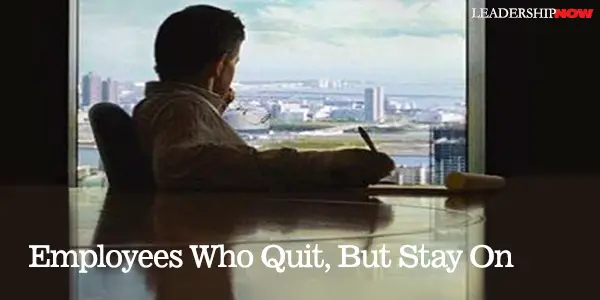 ARE disengaged employees eroding your customer satisfaction, employee retention, productivity and profitability? Research has shown that the average employee engagement figures for the United States are: 30% Engaged, 54% NOT Engaged and 16% Actively Disengaged. Keith Ayers in his book, Engagement Is Not Enough, says that it is a leadership issue and the problem is critical. “Like a cancer, they spread their discontent and do their best to turn the engaged employees against you as well. Even if they don’t succeed, they will undermine the good work your engaged employees are doing by failing to complete their part of projects on time or lowering the overall quality of the job.”
ARE disengaged employees eroding your customer satisfaction, employee retention, productivity and profitability? Research has shown that the average employee engagement figures for the United States are: 30% Engaged, 54% NOT Engaged and 16% Actively Disengaged. Keith Ayers in his book, Engagement Is Not Enough, says that it is a leadership issue and the problem is critical. “Like a cancer, they spread their discontent and do their best to turn the engaged employees against you as well. Even if they don’t succeed, they will undermine the good work your engaged employees are doing by failing to complete their part of projects on time or lowering the overall quality of the job.”
According to the Gallup Organization, the problem usually begins in the first six months when an average of over 60% of employees switch off. This is basically due to the perceived realization that their expectations are not going to be met. They feel powerless to fix the situation and give up but stick around at your expense. Ayers, warns us to avoid four primary obsessions that often result in managers unintentionally increasing the spread of the cancer of disengagement: An obsession with financial results. “To drive myopically toward profit or achieving budget alone, ignoring the needs of employees, customers, and the culture and the values of the organization, is very costly to results.” How much more could you “achieve with passionate employees who go to extreme lengths every day to give their best performance?” An obsession with control. “Control-based leaders assume that people cannot be trusted and send that message to their team. These autocrats are a liability to the organization, squashing natural enthusiasm, creativity, and ambition and driving away the most talented employees.” An obsession with avoiding responsibility. “The number one cause of lack of engagement, poor employee performance, and staff turnover is the relationship the employee has with his or her immediate supervisor. If your team is not performing the way you want them to, first look at whether the leadership they are getting from you is what they need to be able to perform at their best.” An obsession with logic. “Managers obsessed with logic and left-brained thinking are dismissive of feelings—they say that emotions don’t belong in the workplace. They do not believe engagement has anything to do with organizational performance or that people can be passionate about their work. Managers need to understand that emotional intelligence and right-brain thinking are critical skills to become successful leaders in the new global economy.” Ayers offers a discussion of the leadership skills you will need to develop to create passionate employees. He correctly notes, “By now you may be thinking, ‘Don’t the employees have a responsibility to be engaged and perform at their best?’ And you’re right, they do. They should be engaged. But the reality is, in an average organization, 70 percent of them are not! Being right about what they should do won’t make them more engaged. Being effective as a leader will.” According to The Conference Board of Canada, they reported that in looking at a cross-section of studies, that all studies, all locations, and all ages agreed that the direct relationship with one's manager is the strongest of all drivers. Not surprisingly then, they also reported that larger companies are more challenged to engage employees than are smaller companies. 
Posted by Michael McKinney at 12:24 AM
01.03.07

5 Leadership Lessons: Leadership and Motivation 1. Be motivated yourself. You can’t light a fire with a dead match.  Or, putting it differently, when, as Kahil Gibran says, “Work is the expression of love, then motivation will never be our problem." Perhaps the real challenge of leadership today is to locate, release and channel the power of love that flows from deep inner springs within us all. Or, putting it differently, when, as Kahil Gibran says, “Work is the expression of love, then motivation will never be our problem." Perhaps the real challenge of leadership today is to locate, release and channel the power of love that flows from deep inner springs within us all.
These five lessons are from Leadership and Motivation by internationally recognized leadership authority John Adair.
Posted by Michael McKinney at 08:40 AM
|
BUILD YOUR KNOWLEDGE
 

How to Do Your Start-Up Right STRAIGHT TALK FOR START-UPS 
Grow Your Leadership Skills NEW AND UPCOMING LEADERSHIP BOOKS 
Leadership Minute BITE-SIZE CONCEPTS YOU CAN CHEW ON 
Classic Leadership Books BOOKS TO READ BEFORE YOU LEAD |
|